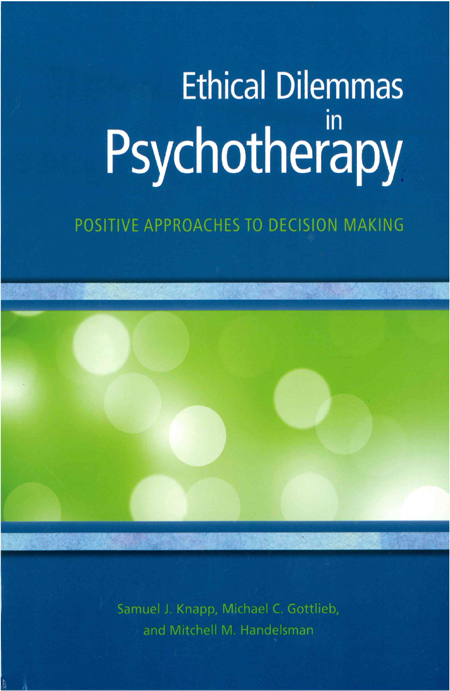

Mental health workers often find themselves in an ethical quandary where there doesn't seem to be an easy solution. This book presents positive ethics with numerous vignettes as a means to overcome such ethical challenegs. The positive approach focuses on not just avoiding negative consequences, but reading the best possible outcomes for both the therapist and the client.
Samuel J. Knapp, EdD, ABPP, has been the director of professional affairs for the Pennysylvania Psychological Association since 1987. He also teaches ethics in the doctoral program in clinical psychology at the Philadelphia College of Osteopathic Medicine and in the graduate program in counseling psychology and is a fellow od Divisin 31: State, Provincial and Territorial Psychology Association Affairs of the American Psychological Association (APA)
Michael C. Gottlieb, PhD, ABPP ,practices forensic psychology in Dallas, Texas and consults on a nationawide basis. He is a clinical professor at The University of Texas Southwestern Medical Center, where he teaches professional ethics and family systems therapy. Dr. Gottlieb is a board certified in family psychology (ABPP) and is a fellow of American Psychology/Law society and four other APA divisions.
Mitchell M Handelsman, PhD, has been on the faculty of the University of Colorado Denver since 1982, where he is now a professor of psychology and a CU President's Teaching Scholar. He is a nationally acclaimed educator who has won awards from the Council for Advancement and Support of Education and the Society for the Teaching of Psychology - a division of the APA - of which he is a fellow.
Chapter 1 What Makes Ethical Choices so Hard?
1. Discuss the concerns of William David Ross regarding ethical codes.
2. Describe the decision theory.
3. Compare the definition of bounded ethicality by Chugh, Bazerman and Banaji (2005) and Bazerman and Tenbrunsel. (2011)
4. Define ethical fading.
5. Compare System 1 and System 2 thinking.
6. Describe the cognitive load.
7. Compare the availability heuristic and representative heuristic.
8. Define confirmation bias, prospect theory and loss aversion.
9. Define the affect heuristic.
Chapter 2 The Ethical Decision-Making Model
10. Discuss Step 1 and Step 2 of the decision-making process.
11. Discuss Step 3 of the decision-making process.
12. Discuss Step 4 and Step 5 of the decision-making making process.
13. Describe several ethical dilemmas found in the enforceable standards.
Chapter 3 The Quality Enhancement Model
15. Describe the maintenance of a distal strategy.
16. Compare distal and proximal strategies.
17. Describe the four quality enhancement strategies.
18. Describe the prompt list.
Chapter 4 The Ethics Acculturation Model
19. Describe the ethics acculturation model.
20. State the two major dimensions of acculturation.
21. Describe the four types of acculturation strategies.
22. Discuss the four stages of acculturation according to Berry and Sam. (1997)
23. Compare assimilation and separation.
Chapter 5 Professional Competence
24. Discuss the two questions and answers often asked of psychologists with whom we consult.
25. Define supererogatory obligation.
26. Define the hot-cold empathy.
27. Discuss the importance of taking notes.
28. Compare process advice and substantive advice.
Chapter 6 Boundary Issues
29. Define General Principle A: Beneficence and Nonmaleficence of the American Psychological Association (APA 2010) Ethics Code.
30. Compare a boundary crossing and a boundary violation.
31. Discuss the research of Overton, Hensley and Tallichet (2012) regarding animal cruelty.
Chapter 7 Informed Consent
32. Describe informed consent discussions at the beginning of treatment.
33. Describe goal setting during therapy.
34. Discuss the use of the Internet to assist the psychologist with therapy.
35. Describe the transfer syndrome.
Chapter 8 General Beneficence With Dangerous Patients
36. Compare beneficence, general beneficence and nonmaleficence.
37. Discuss therapy for the patient when danger is based on a future event.
38. List several threats against psychologists.
Chapter 9 Social Justice
39. State the APA Ethics Code when a [patient uses hate-filled speech.
40. Discuss findings by Saad, 2010, regarding morally diverse patients.
41. Define judgement-neutral psychotherapy.
© 2007 - 2010 Homestead Schools, Inc. - Webmaster: ITSYS Solutions